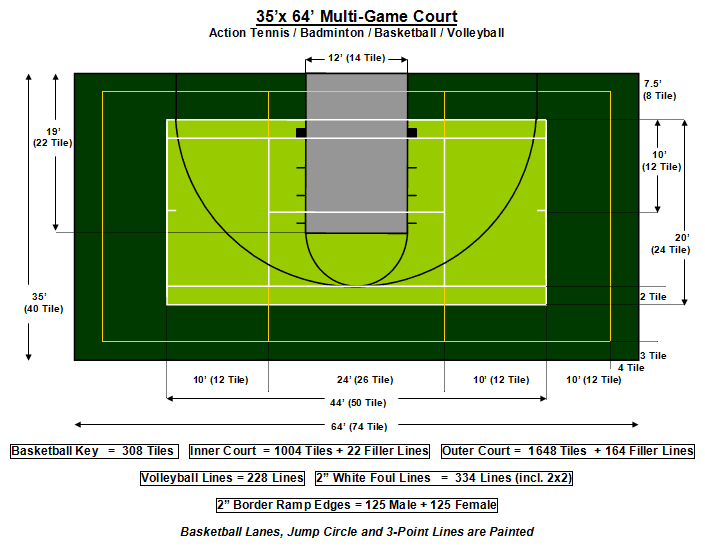Home »
Misc »
How do they paint basketball courts
How do they paint basketball courts
How They Do It: Pulling Off Today’s Bold Basketball Floors
Larger-than-life metallic Spartans on the new San Jose State University basketball floor created an out-of-the-box challenge for United Floor Services Inc. (Courtesy San Jose State University)
Not long ago, gym floor specialists were known mainly for their ability to travel long distances to a job, use their riding sanders to sand vast expanses of maple, paint their lines and walk miles back and forth to get finish on the floor. It wasn't a niche involving much creativity or imagination, and, except for painting the lines, it didn't require much finesse, either.
Times have changed. While coating gyms still involves a lot of walking, what happens before that final coat could hardly be called boring. Today's basketball courts are in-your-face, with huge logos and other wild graphics that are all about branding. Many people date this trend to the University of Oregon floor that debuted in 2010 (more on that in the sidebar "Into the Woods" below), with its forest of tall fir trees that broke the mold of traditional floors and even led to rule changes in the NCAA.![]()
The effects have been far-reaching. While many NBA floors remain tame in comparison, NCAA floors seem to compete to outdo each other, and high schools and even junior highs and grade schools are catching on to the trend. How do wood floor pros execute the crazy designs? HF talked to some gym floor specialists to find out.
United Services Inc.
United Services Inc. in Idaho Falls, Idaho, has a long history of doing basketball floors, but they really put themselves on the map when they created the University of Oregon floor in 2010 (see the "Into the Woods" at the end of this article). They've done many tricky designs since then, but the most elaborate one was this San Jose State University Spartans floor.
The new floor design originated with the coach, who had previously been at Boise State, known for its bold branding, including its "Smurf Turf" blue football field and its basketball floor with huge bronco heads inside the three-point lines. The coach wanted the same kind of branding for his court at San Jose State.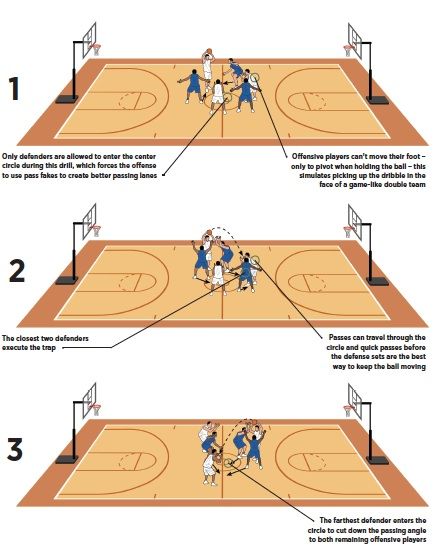
"They said, 'We want these Spartans faux-painted on the floor,'" United Services' General Manager Shane Matheson says. "We had to figure out what that was! On top of that they picked these metallic paints—golds, coppers, silvers—that are impossible for anything to stick to."
Once they had an image of the Spartans they liked, it was created in Adobe Illustrator. To convince the client they could actually create the design on a floor, United created an 8-foot sample. With that proof in hand and client approval, the outlines of the design were transferred to the plotter to create stencils—many, many stencils. The stencils are carefully adhered to the gym floor and have layers, so when one paint area is dry, a section can be removed and another area painted. This process can go on repeatedly depending on the complexity of the graphic.
'Countless layers' of paint and transfer paper, along with three artists, were necessary to complete the Spartans graphics on the San Jose State University basketball floor.
The main Spartan graphic is 27 feet tall and 48 feet wide. The first stencil created the general outline of the Spartans for the base color. At that point three artists went to work on the graphic at the same time, using stencils along with faux painting techniques. "We put the base paint layers down, pull the vinyl up, then take transfer paper—what they use on top of vinyl—and put that on top of it and cut it," Matheson explains. "It was countless layers of paint and transfer paper and cutting by hand."
The client wanted the graphic to be perfect, and the artists on the floor, including United's Project Supervisor Nathan Banks, were perfectionists, too. When the desired effects—texture of the skin, cracks in the old pounded brass armor—in some small sections didn't look right, they sanded it off and started all over again.
Because the paints were metallic, they presented particular challenges. In addition to the fact that Matheson found "not only does it look like gold, it costs like gold," due to its composition, the appearance of the paint would change depending on direction of the brush strokes. So, the crew had to airbrush the metallic paints. Sometimes one of the artists would stand on a 16-foot ladder to direct the others during airbrushing so they could be sure to get the correct overall effect. They employed stippling techniques—using small dots—and also sprayed on highlights and shadows to make the floor pop.
So, the crew had to airbrush the metallic paints. Sometimes one of the artists would stand on a 16-foot ladder to direct the others during airbrushing so they could be sure to get the correct overall effect. They employed stippling techniques—using small dots—and also sprayed on highlights and shadows to make the floor pop.
Adhesion was always on their minds, Matheson says, adding that they knew the college would be taping a volleyball court over the Spartans graphic on a regular basis, so the crew was religious about making sure each paint and finish layer would be correctly bonded.
{rblink 2331}One of the biggest challenges was hand-abrading the entire graphic, Matheson says. ("I've seen guys spend hours hand-painting a logo and then run a buffer over it and ruin it," he says.) Then a sealer with "very good adhesion characteristics" was used to coat the graphic before the buffers abraded the rest of the floor.
"If you get close to them the details are incredible. You can see sweat, patina, cracks in the armor.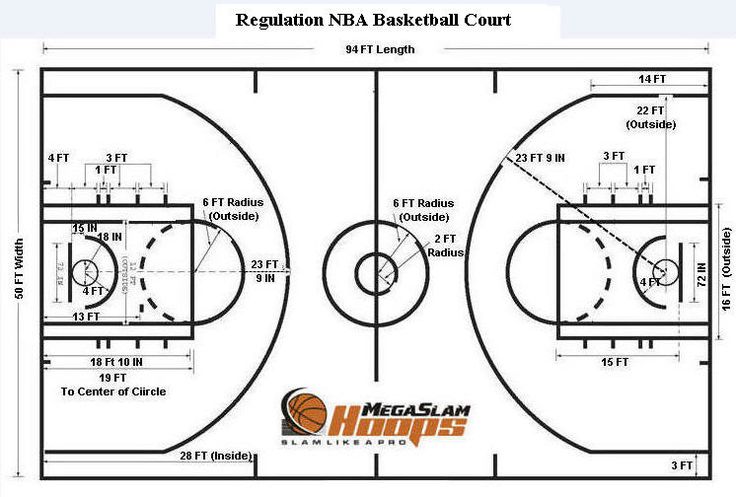 When we were done they said, 'That is so much better than our expectations,'" Matheson says.
When we were done they said, 'That is so much better than our expectations,'" Matheson says.
By comparison, the rest of the floor was easy. The large logo was painted—a routine process for them—and inside the three-point lines, the maple floor was stained. Although Matheson says the first time they ever stained a maple floor it turned out "nasty," by now they have their process—involving not sanding to too high of a grit, conditioning and water-popping the floor correctly—down to a science.
The university ships the court back to United every year to touch up and recoat, not risking damage to the floor that cost at least $250,000.
Pulling off a floor like this takes decades of accumulated experience, Matheson says. "It's a team effort to do it—all the way from the selling of it, to the design of it, to the execution and maintenance of it. It just takes a lot of people to do this, and everything has to fall in line."
Worst Mistake: "When the Seattle SuperSonics moved to be the Oklahoma City Thunder, it was an elaborate floor. We shipped it out, and three days before the game, they put it down. Two days before the game they were certifying the floor and they called us and said the three-point line was 1 foot off. It was a brand-new arena, brand-new franchise. We were out there all night palm-sanding the three-point line off the floor. The finish dried hours before the game." We shipped it out, and three days before the game, they put it down. Two days before the game they were certifying the floor and they called us and said the three-point line was 1 foot off. It was a brand-new arena, brand-new franchise. We were out there all night palm-sanding the three-point line off the floor. The finish dried hours before the game." |
Tips: • Be sure images clients want reproduced aren't copyrighted. • Allow enough time for the whole project. • Give paint extra cure time. • Paint layers should be thin. |
| Eric Maxwell/AECOM Into the Woods When people think of current trends in out-of-the-box basketball floor designs, many immediately think of the University of Oregon floor unveiled in 2010, which features a forest of fir trees surrounding center court.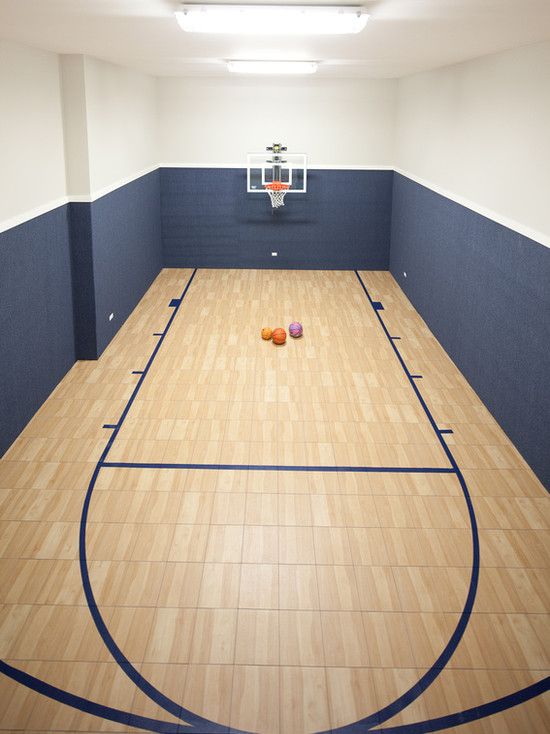 Designed by Nike designer Tinker Hatfield, the graphics were executed by United Services Inc., and General Manager Shane Matheson recalls when he was first flown in to Eugene, Ore., to meet with all the Oregon big names to see an initial design: Designed by Nike designer Tinker Hatfield, the graphics were executed by United Services Inc., and General Manager Shane Matheson recalls when he was first flown in to Eugene, Ore., to meet with all the Oregon big names to see an initial design: "On the wall they had hung a mockup for the floor. They said, 'This is our floor; can you do this?' I started to laugh. They said, 'What are you laughing about?' I said, 'It's completely doable, but it's going to cost a ton of money. Get a dump truck and back it up to the bank.'" Matheson says it took them about a month and a half to figure out how to execute the design—one unlike anything seen before. Almost two miles of stencil materials were used to create it. "It was a fantastic experience for us, because we learned we could do things people said were impossible. You either really love that floor or hate it, and that was their marketing strategy all along." |
More photos of this United Services project:
Praters Athletic Flooring
'We really pushed the limits of what paints and sealers can do with this one,' says Praters' Mark Frainie of the 2016 Women's ACC Championship court.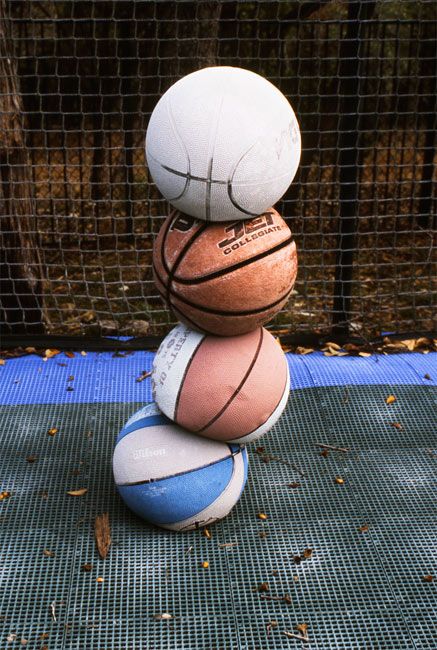
From its facility in Chattanooga, Tenn., Praters ships wild basketball floors all across the country. "Facilities don't get to sand their court down to bare wood very often. When they do, we encourage them to do something different, and we allow them to push the limits of court design by working with our design department. 'Whatever they want' is our attitude; let's make this particular facility a showplace," says President John Prater. "It doesn't matter whether it's the NCAA or a high school or the NBA, it's the same approach."
In the last couple years, the company has come to embrace the technique of using paint colors within their sealer coats, because the trend right now is for clients to want to see the grain of the floor. "That allows you to get any color of the rainbow, including colors that aren't traditional stain colors," Prater says. The technique also allows the company to match Pantone Matching System colors—a typical request for universities and schools particular about their branding—with the transparent look of a stain but without the need to use a traditional painted logo or other graphic.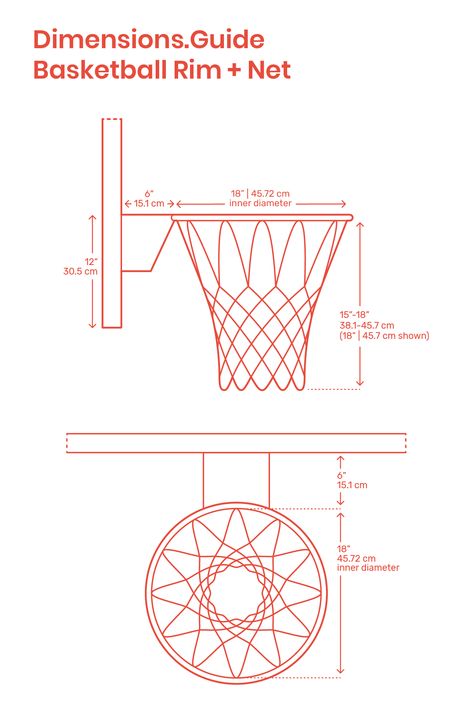 For earth tones, the company adds a concentrated dye in the sealer, and for other colors, paint is mixed with the sealer. "It gives us a lot more creative flexibility," Prater says.
For earth tones, the company adds a concentrated dye in the sealer, and for other colors, paint is mixed with the sealer. "It gives us a lot more creative flexibility," Prater says.
It does require more work in doing samples, however. Matching a PMS color with paint is straightforward since the paint is opaque. Matching a PMS color in a sealer requires lots of sampling and back and forth to get approval, since the color of the natural wood becomes a factor, and typically the colors used must be darker than the end color to compensate for the lightness of the maple.
There's a fallback when using pigments in sealers, too. "If it's absolutely horrible, I can always paint over it," Prater says. Because it doesn't penetrate the wood like a stain does, it tends to not bleed as much, and if the client ends up not liking it, you can "buzz it off with a sander real quick," he adds.
{rblink 2144}Either way, the technique is not a good one for a typical residential contractor to use since any areas with more or less finish show the color darker or lighter. It works on these types of jobs because there are no start or stop marks—the sealer application starts and stops on the masked area, or is simply pulled straight wall to wall.
It works on these types of jobs because there are no start or stop marks—the sealer application starts and stops on the masked area, or is simply pulled straight wall to wall.
No example of this technique shows it off better than the elaborate 2016 Women's ACC Championship court. The ACC had a good idea of what they wanted for their design; it features large geometric shapes, with blended blue, green and pink shades across the three-point areas, "as if they were painted by a giant artist's hand," says Praters Creative Director Mark Frainie. "We really pushed the limits of what paints and sealers can do with this one, as well as the techniques used for application," adding that when they first got the design concept, they weren't sure how they would achieve it.
The initial process for the new portable floor was typical: It was assembled in Praters' facility and sanded, then coated with two coats of sealer. Then three-point lines were striped, and three colors of pigmented sealer were applied using an 18-inch T-bar with a nylon foam pad.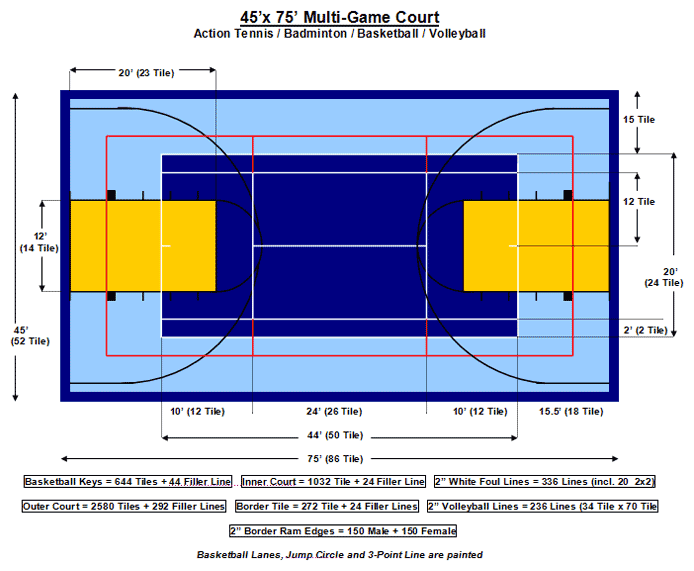 During application, the T-bar was treated "as if it were a huge paintbrush," and all the color was applied at one time—so there was only one shot to get the colors right. And it had to be done quickly to keep the product workable. It was not for the faint of heart, says Prater. After the pigmenting, the logos and lettering were applied, buffed and the final coat(s) were applied. "At the end of the day, the floor looked just like the picture—which is always nice!" Prater says.
During application, the T-bar was treated "as if it were a huge paintbrush," and all the color was applied at one time—so there was only one shot to get the colors right. And it had to be done quickly to keep the product workable. It was not for the faint of heart, says Prater. After the pigmenting, the logos and lettering were applied, buffed and the final coat(s) were applied. "At the end of the day, the floor looked just like the picture—which is always nice!" Prater says.
Tips: • Make sure everything you need is available on site, from tools to applicators. • Creating samples for customer approval is critical. • Experiment with new techniques on panels at your shop until you can get them down correctly. • Having a support team, from the office to on the floor, is critical to be able to pull off complicated designs. |
Training: For those interested in learning how to pull off complex basketball court designs, Praters doesn't keep its techniques a secret. In fact, its cool "The Edgegrain" blog on the company's website at pratersflooring.com has a series of "How it's Done" and "Tips & Tricks" videos showing how they do different techniques for their court designs. The company is also willing to act as a consultant. "We are partnering with more and more contractors around the country who are maybe hesitant to do a more complicated job. We provide anything from turnkey—we'll sand it and seal it and do the graphic application—to talking them through the design on the phone or sending one person out to the job to work on a project," John Prater says. In fact, its cool "The Edgegrain" blog on the company's website at pratersflooring.com has a series of "How it's Done" and "Tips & Tricks" videos showing how they do different techniques for their court designs. The company is also willing to act as a consultant. "We are partnering with more and more contractors around the country who are maybe hesitant to do a more complicated job. We provide anything from turnkey—we'll sand it and seal it and do the graphic application—to talking them through the design on the phone or sending one person out to the job to work on a project," John Prater says. |
Recent Creative Projects Ball Up Streetball:
"This is one of the most challenging designs we have worked on. The main court features five shades of gray and is designed to mimic the pattern on a heather-gray T-shirt. Coming up with a process to create this look consistently over the entire court took months to figure out and weeks to execute," says Praters Creative Director Mark Frainie. Abby Mitchell Texas Christian University: Praters worked with Ponder Company Inc. in Dallas to create this volleyball court. It and a matching basketball court are both based on TCU's frog-skin patterned uniforms. "There is so much detail that the task proved to be very labor-intensive and time-consuming," Frainie says. "The Ponder Company was able to allocate a tremendous amount of resources to this task, led by some really great and talented guys, to make quick work of it." Don Jedlovec, Santa Clara Athletics Santa Clara University:
Designed by Tinker Hatfield, the Nike designer who also created the University of Oregon court, the floor features the university's architecture. Praters coordinated with San Carlos, Calif.-based H.Y. Floor & Gameline Painting Inc. on the floor, employing paint in sealer coats for the architectural design. "The flooring professionals at H.Y. Floor made the process of installing the stencil and applying the various colors for the mission a breeze," Frainie says. |
More photos from these Praters projects:
Sportstech Flooring
'You've just got to know what you're doing and be confident in what you're doing ... We've made mistakes; everybody does. It's part of the learning process,' says Andrew Ledford, project manager at Sportstech Flooring.
Complicated staining and dying jobs along with big graphics aren't just for NCAA and NBA floors. The trend has reached down to pre-collegiate levels, too, and companies like Sportstech Flooring in Tulsa, Okla., make their living specializing in gym floors in their region, handling all the design work, artwork and printing of stencils in-house. At Sportstech, "we probably do about 150 screen and coats per year and probably have 12 new floors going in this year," says Outside Salesperson Kathryn Gould.
The floor at Nathan Hale High School in Tulsa, Okla., (shown above) is a great example of how even high schools are taking a more modern approach with their basketball floors.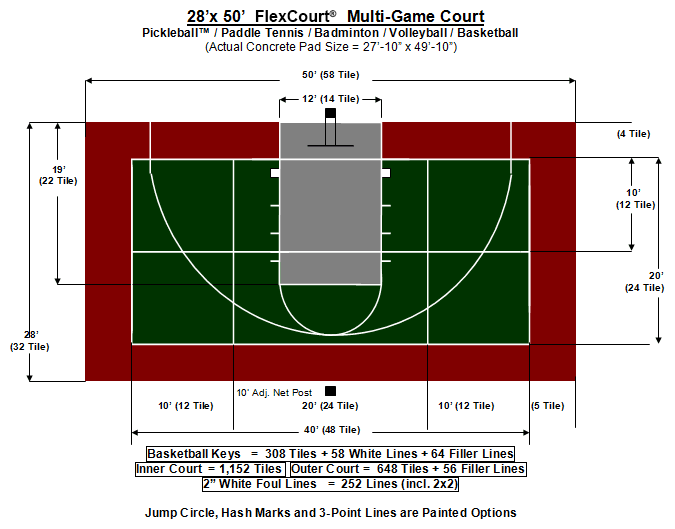 The fixed maple floor was sanded and screened, and tape was laid down for the lines for the lanes and three-point arc. The lanes and basketball circles were premasked to leave only the three-point arc exposed. A white stain was mixed with sealer and applied to the three-point arc with a T-bar. After at least four hours of dry time, they peeled up the premasks in the key and premasked everything around the basketball circles, then coated those with sealer with a brown tint. The next day they peeled everything up, ran a maroon pad over all of it to knock down the grain and sealed the entire floor with two coats of sealer without any color.
The fixed maple floor was sanded and screened, and tape was laid down for the lines for the lanes and three-point arc. The lanes and basketball circles were premasked to leave only the three-point arc exposed. A white stain was mixed with sealer and applied to the three-point arc with a T-bar. After at least four hours of dry time, they peeled up the premasks in the key and premasked everything around the basketball circles, then coated those with sealer with a brown tint. The next day they peeled everything up, ran a maroon pad over all of it to knock down the grain and sealed the entire floor with two coats of sealer without any color.
Once the seal coats were dry, the floor was screened because "paint has to have something to stick to," says Sportstech Project Manager Andrew Ledford. This logo was relatively easy, he says, because it was only white and gray. "Whenever we do a stencil, painting the outline is first, and then we just work different colors one at a time," he explains. So the white was painted, and, once dry, the areas were cut out for the gray paint. Each color had at least two coats of paint. "After it's all set, you pull all the premask up and you have a single logo," Ledford says.
So the white was painted, and, once dry, the areas were cut out for the gray paint. Each color had at least two coats of paint. "After it's all set, you pull all the premask up and you have a single logo," Ledford says.
"If you don't do it a lot, it's easy to get lost in a logo," Ledford says. "You might pull the wrong color. If you're using paint, it's easier, because you can repaint with the right color. If it's stain, you're done for and you have to resand." Once the logo and lines were painted, the entire floor was abraded and the topcoats are applied for a completed floor.
Ledford says he is happy to see the trend toward using stains and tints that show the grain in the wood. "A while ago, every customer thought the more paint they had on the floor, the better it looked," he says. "But paint just sits on top, and you have to worry about scuff marks."
Tips: • Follow directions about how much color you can add to the sealer to avoid peeling.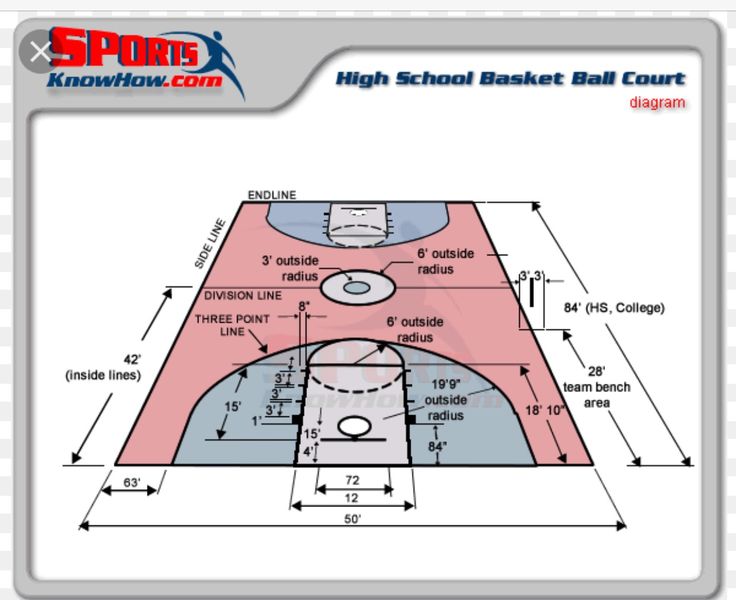 • Sealer coats with color must be applied carefully but fast enough that they don't start to set up and tear. • Be prepared to do multiple coats of paint, particularly for some colors. |
The Sports Authority When it comes to maple sports flooring, the Maple Flooring Manufacturers Association Inc. is the authority. Formed in 1897, the MFMA publishes northern hard maple/beech/birch grade standards and floor care recommendations, and its PUR Standards use ASTM standards to define acceptability for shock absorption, vertical deflection, area of deflection, ball bounce and, for finishes, surface friction. Complete info on MFMA can be found at maplefloor.org. |
In The Paint Basketball
Home>Sports>Basketball>Basketball Glossary
PreviousNext
Table of Contents
- The Paint
- How Big Is the Paint in Basketball?
- History and Rules
- Gameplay
- FAQ
The Paint
The paint in basketball is a rectangular area on the court extending from the foul line to the baseline with perpendicular lane lines enclosing the shape.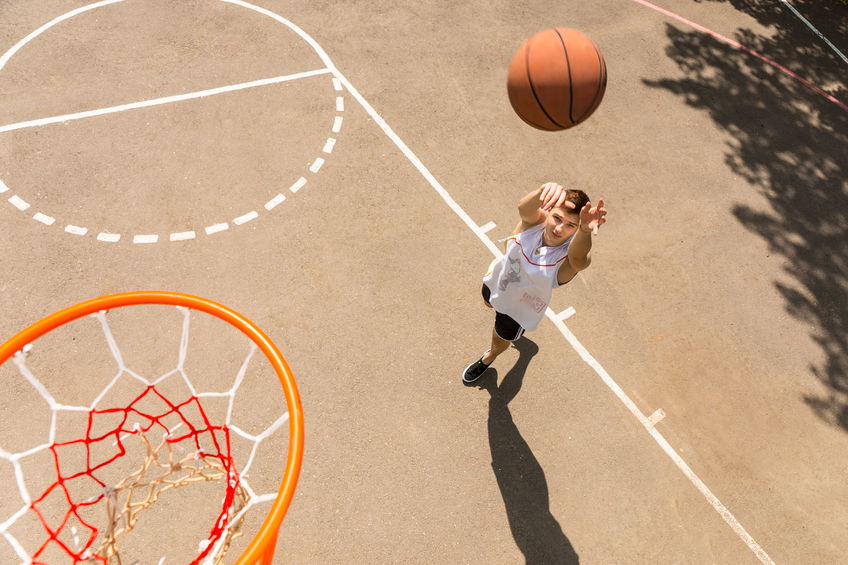 It is also known as the “foul lane'' or “the key,” for short.
It is also known as the “foul lane'' or “the key,” for short.
The paint gets its name from the shading done on courts to denote its shape. Attached to the paint are the blocks where players line up for free throws. The low blocks are a common spot for players to post up.
Different leagues have slightly different shapes and markings for the paint. The NBA and FIBA have a restricted area within the paint, but the NCAA does not. This arc denotes where a player is unable to draw a charge from. There is also a dotted semicircle within the paint for leagues that do not use alternating possessions, like the NBA.
How Big Is the Paint in Basketball?
The size of the paint varies among basketball leagues. In the NBA and the WNBA, the paint is 16 feet wide and 19 feet long, with the foul line painted 15 feet from the backboard. In NCAA play, the paint is the same length, with the foul line in the same position, but it is narrower, at 12 feet wide.
History and Rules
In basketball, certain rules apply to the paint.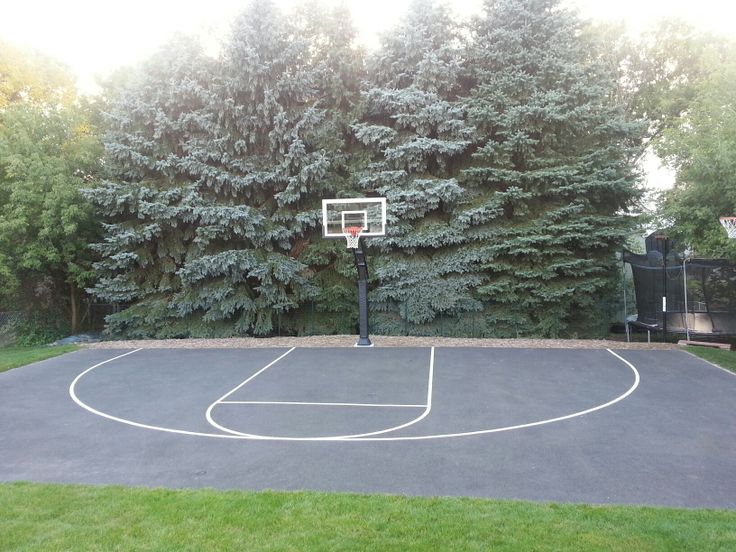 Violating these rules can lead to a technical foul or turnover, depending on which team possesses the ball.
Violating these rules can lead to a technical foul or turnover, depending on which team possesses the ball.
NBA Basketball Paint Violations
Unless actively guarding a player, defensive players are forbidden from standing inside the paint for more than three seconds. This deters having a player in a zone scheme who just stands underneath the basket. This violation results in a technical foul. Offensive players are also not allowed to stay in the paint for more than three seconds, and this infraction results in a turnover.
NCAA Basketball Paint Violations
In NCAA basketball, there is no defensive three-second violation. This allows teams to use a zone scheme on defense, which typically features a defender roaming the middle of the paint. However, there are still offensive three-second violations in NCAA basketball, with the same rules as the NBA.
FIBA Basketball Paint
Similar to NCAA basketball, FIBA basketball does not penalize defensive players for standing in the paint for more than three seconds. Consistent with most other leagues worldwide, FIBA rules state that an offensive player may not stand in the paint for more than three seconds.
Consistent with most other leagues worldwide, FIBA rules state that an offensive player may not stand in the paint for more than three seconds.
Gameplay
Since players are more likely to make shots closer to the basket, a common statistic noted is points in the paint (PITP). The NBA also records an advanced statistic called paint touches, which averages a player’s number of possessions in the paint per game. Teams that can outscore their opponent inside typically have a better chance of winning the basketball game.
FAQ
What is the paint in basketball?
The paint itself is the rectangular colored area directly surrounding the basket. It has four hash marks extending from it for players to line up on during free throws. The paint’s width varies depending on the league; in the NBA, the lane is 16 feet, and in college, it is 12 feet.
What is the purpose of the paint in basketball?
The paint allows referees to more easily officiate the game by making a colored area where they can clearly enforce certain rules.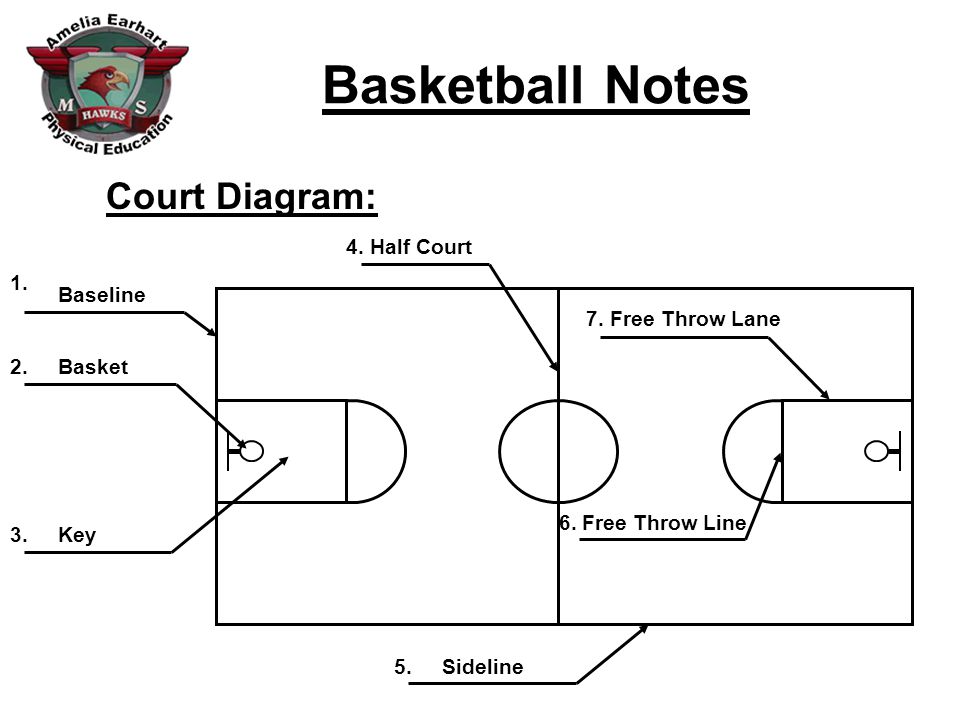 The paint is also a reference for players to position themselves both on offense and defense. Plays are drawn up where players need to be in certain spots on the court, and the paint is an easy reference point.
The paint is also a reference for players to position themselves both on offense and defense. Plays are drawn up where players need to be in certain spots on the court, and the paint is an easy reference point.
What are the rules of being in the paint?
There are rules regarding how long a player can stand still in the paint. In the NBA, defensive and offensive players are only allowed to stay inside the paint for a maximum of three seconds before exiting the paint. However, players may exit and then immediately re-enter the paint as often as they want. An exception to this rule is that defensive players can stay as long as they want if they are within arm's length of an offensive player. In NCAA and high school basketball, only offensive players are prohibited from standing in the paint for more than three seconds. These rules are in place to deter players from standing in the paint for an entire possession and not moving around the court.
In basketball, what does it mean to “go hard in the paint”?
The phrase “going hard in the paint” is a common term in basketball, which is used to define a situation where a player is advancing aggressively towards the basket in an attempt to score, by necessity passing through the paint.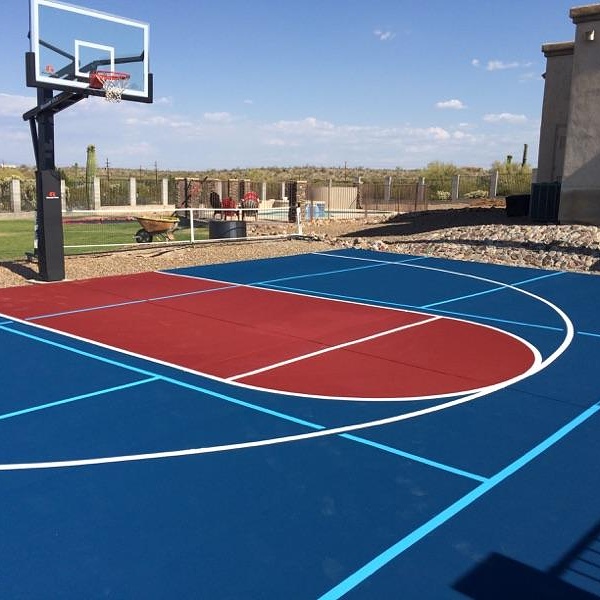 In basketball, being “in the paint” refers to when a player positions themselves in the area of the court known as the paint, which is the shaded rectangular area surrounding the basket. The paint is also known as the lane, key, and free throw lane.
In basketball, being “in the paint” refers to when a player positions themselves in the area of the court known as the paint, which is the shaded rectangular area surrounding the basket. The paint is also known as the lane, key, and free throw lane.
PreviousNext
Pages Related to In The Paint Basketball
- Trey Basketball
- Dream Team Basketball
- The Big Dance Basketball
- Half Court Basketball Game
- Hang Time Basketball
- Secondary Break Basketball
PreviousNext
Basketball court markings: standards and norms
Author of the article
Khvatkov Dmitry
Consultant in the production of rubber coatings
Basketball field marking requirements are approved by the FIBA standard. The site must be flat with a hard surface, free of bends, cracks and other obstacles. The accepted dimensions of the field are 28 m long and 16 m wide. By NBA standards, the field is slightly larger: 28.7 m (94' ft) long and 15.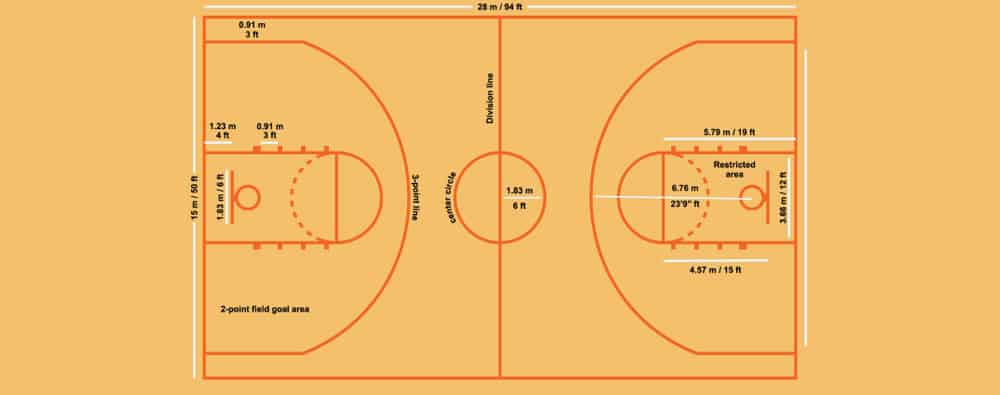 3 m (50' ft) wide.
3 m (50' ft) wide.
Areas not intended for international competitions may differ from accepted standards (for public use, in schools or universities, etc.) and usually vary from 20 to 28 m in length and from 12 to 16 m in width.
Basketball Court Marking Standards
Basketball court markings are conventionally divided into 5 components:
- Boundary lines. They are located along the perimeter of the site and set its size. The lines that run along the field are called side lines, and those that are behind the baskets are called front lines.
- Central line. Divides the court in half parallel to the front lines.
- Central zone. It is a circle and is placed in the middle of the center line, and, accordingly, in the center of the entire field.
- Three-point line. It is a semi-ellipse and is located around the shields on both sides of the field. It limits the close range.
- Free throw line. It is located in front of the boards parallel to the front line and is limited on the sides by paint lines.

The standard line width is 5 cm. All outlines and lines must be of the same color (usually white) and be clearly visible from anywhere on the court.
Common lines
Common lines are used to limit the playing area of the court. The side lines (along the field) according to FIBA standards should be 28 m long, and the front lines - 16 m. For public areas, deviations from the accepted standards are allowed. Typically, basketball courts in schools or gyms are made from 20 m long and 12 m wide.
Central lines
The center line is parallel to the front and divides the field exactly in half. According to the standards - it should extend beyond the side lines by 15 cm on both sides.
In the middle of the center line there is a circle with a diameter of 3.6 m, which limits the central zone of the field. In this zone, the ball is played at the beginning of the game.
Three-Point Line
Three-Point Lines are located around the backboards on both sides of the field and consist of two straight lines 2. 9 long9 m and a semicircle. Straight lines run perpendicular to the front at a distance of 0.9 m from the side lines. Despite the fact that visually the distance from the ring to the side of the three-point line seems to be less than to its central part, the distance from the backboard to any point is 6.75 m.
9 long9 m and a semicircle. Straight lines run perpendicular to the front at a distance of 0.9 m from the side lines. Despite the fact that visually the distance from the ring to the side of the three-point line seems to be less than to its central part, the distance from the backboard to any point is 6.75 m.
Penalty lines
Penalty lines limit the nearest area at the backboard. They consist of a trapezoid and a free throw zone.
Despite the name, the "trapezium" is a rectangle (until 2009year it really was a trapezoid), which is located under the shield. Its dimensions are 5.8 meters long and 4.9 meters wide. The shield is located at a distance of 1.575 m from the end line in the middle of the court. In front of the backboard, at a distance of 1.25 m, there is a semicircle that limits the area for picking up the ball.
At a distance of 4.225 meters from the backboard, the trapeze zone ends and the free throw zone begins. It is a semicircle with a diameter of 3.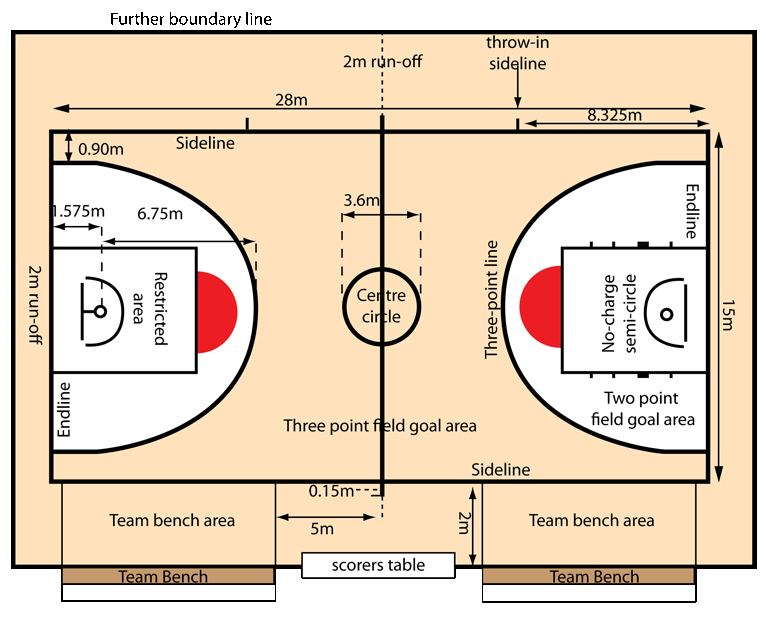 6 m (like the central circle).
6 m (like the central circle).
Paint zone lines
These lines are serifs on both sides of the trapezoid (parallel to the side lines). They limit the areas for players who are fighting for the ball during a free throw.
Zones on the basketball field
The basketball court is divided into zones using markings. Each zone has its own specific rules.
Center circle
The center circle is used as a separate kick-off area at the start of the game. One representative from each team stand in a circle from their side and fight for the ball in a jump, after it is dropped by the referee. All players are exclusively on their side of the field, except for one who rebounds on the opponent's side.
Neutral zone
The peculiarity of this zone is that as soon as the player of the attacking team with the ball crosses the center line and is on the side of the opponent, he cannot pass the ball to the player of his team who is on the other side of the field (i. e. behind center line on your side).
e. behind center line on your side).
Three-point zone
The three-point line limits the near zone of the shot. Hitting the basket from outside the basket brings the team three points. If the throw was made inside the zone, then it brings two points.
Three-second zone
This is the zone in close proximity to the ring. It is called three-second, since the player of the attacking team cannot be in it for more than three seconds. Most balls are thrown in this zone, so when attacking, it provides maximum protection.
Free throw area
In controversial situations, a free throw is provided from this area. The player of the attacking team must score the ball without stepping over the line of the trapezoid. At the same time, the players of both teams are not in the three-second zone. They take up positions along the paint lines on the sides of the trapezoid and may not step outside the lines until the free throw shooter has shot the ball.
How to mark a basketball field?
Basketball field markings, whether it is an international competition court or an open-air amateur field, are best applied using special equipment. This will ensure the long life of the coating, the lines will not clog and will promote fair play.
This will ensure the long life of the coating, the lines will not clog and will promote fair play.
You can order the marking of a basketball court in Moscow and the Moscow region from Rezkom. We will measure the premises and develop a design project for the field so that it complies with generally accepted rules and is convenient for operation. For more details, you can contact our manager by phone 8-495-64-24-111.
Construction of a turnkey basketball court|SportObject
The company "SportObject" offers its services in the construction of turnkey basketball courts. Trusting the construction of our company, you get a whole range of turnkey services, including design, ground work, laying the base and coating, marking and other construction work. We strictly adhere to the agreed deadlines and provide our clients with a work schedule that indicates the start and completion dates for construction.
Find out why it is safe to cooperate with us
Details
Calculation of the cost of the object
To find out the estimated cost of your object, select the options below or use the detailed calculator available by clicking the "Make a detailed calculation" button.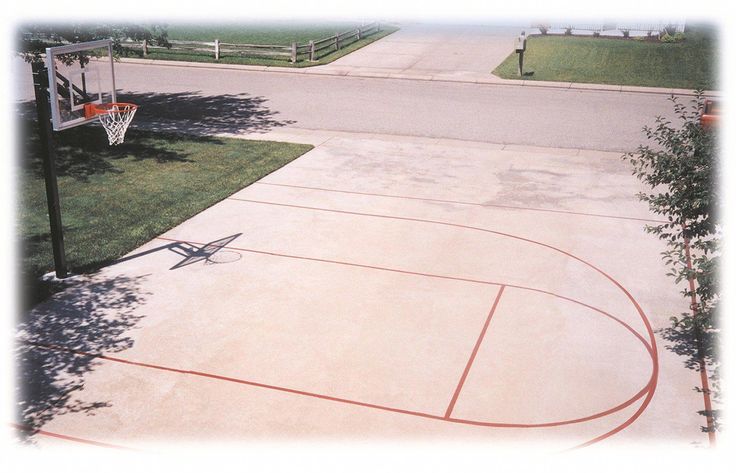
1. Coating:
Choose the type of coating for your object.
Not selectedAcrylicRubber crumbModular plasticPolyurethane
2. Destination:
Specify where your object will be used.
Not selectedFor suburban developmentsFor educational institutionsFor competitionsFor sports organizationsFor private business
3. Your object:
Specify whether your object is located: indoors, outdoors or it needs a hangar.
Not selectedOutdoor (outdoor)Indoor (indoor)To be built (prefabricated hangar)
4. Field sizes:
Select the appropriate field size from the provided list.
Not selectedCustomStandard30x18 - (playing dimensions 28x15) 34x19 - for competitions (playing dimensions 28x15)
Specify the parameters of your object in a detailed calculator and get an approximate cost of the service.
Budget savings
We help reduce your costs by up to 40% and avoid unnecessary overpayments.
Project in 3 days
We will design and calculate the exact cost of your object in just 3 days.
5 year warranty
We give great guarantees for imported goods and materials from our warehouse.
421 590* 421590 RUB
* The price is indicated for the basic package with a coating without a base. You can also use the detailed calculator.
Implementation example
Private sector basketball court
Difficulty:
Rubber slabs for outdoor sports grounds are perhaps the most reliable and rational option of all. The coating is made of high-strength crumb rubber and a binding polymer (polyurethane adhesive).
The coating is made of high-strength crumb rubber and a binding polymer (polyurethane adhesive).
More details
Get a consultation
Request a call back and one of our managers will advise you on all your questions
You can also call
8 (495) 240-82-24
By submitting your personal data through the forms on the site, you give your consent to the processing of personal data in accordance with Federal Law No. 152-FZ "On Personal Data" dated July 27, 2006, as amended on July 1, 2017.
Stages of construction on the example of a football stadium
The thickness of the foundation pit and the amount of materials that are needed for your foundation, we select depending on the size of the field. We select drainage and other systems based on the regional location (how much precipitation is in your region, what kind of drainage is needed). Additionally, we equip drainage wells, or divert them to the drainage system.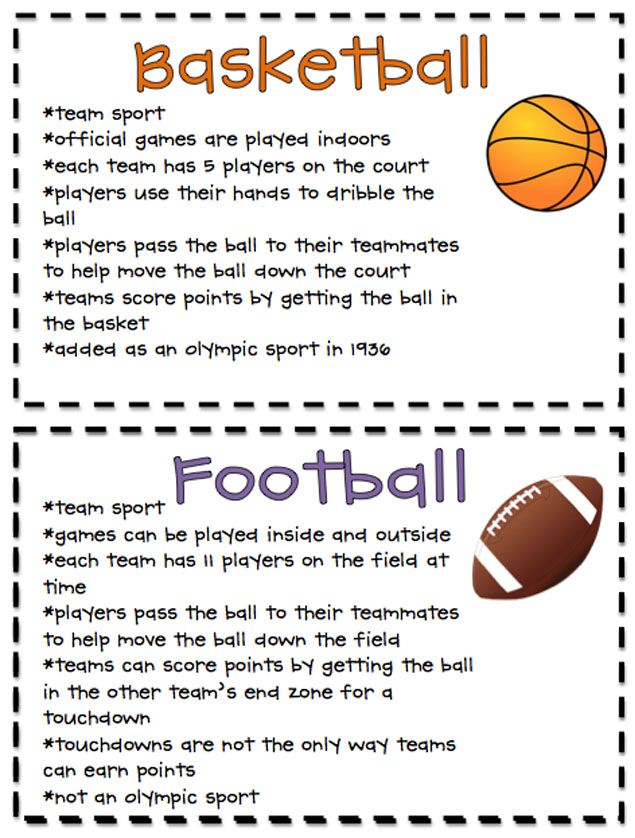 Field slopes of several different types depending on site operating conditions.
Field slopes of several different types depending on site operating conditions.
Preparation of excavation, sand bed, drainage system
The quality of a football field is more than half dependent on the quality of the base! Our base is a monolithic solid single layer, which over the years does not form any fractures, the soil does not go anywhere and remains flat throughout the entire period of operation. Relatively speaking, even if a tractor passes over the base, there will be no tire marks, because everything is solid and dense!
Sequential compaction of base layers
We carry out all types of additional improvement works: we can install a fence for you, pave an asphalt path to something, level the territory, paint walls, borders, etc. We will perform all the required related work!
Installation of the curbstone
The laying of the artificial grass itself is as important as the preparation of the base. When laying the field, an important aspect is gluing the rolls and cutting the markings. Gluing must be done securely. The material in the work requires getting used to, because the two-component glue rolls down after a while and they need to work quickly.
Gluing must be done securely. The material in the work requires getting used to, because the two-component glue rolls down after a while and they need to work quickly.
Laying the grass on the prepared base, gluing it and cutting the markings
Be sure to remember: the gate is installed with a safety requirement so that it does not turn over. Therefore, this aspect is given special importance. In this regard, the gate is either concreted or attached to an accompanying fence.
Installation of the goal
The backfill of a football field determines a large part of the performance of the game. Backfilling is a responsible job, because the presence or absence of drops and bumps, which will eventually be felt during the game, depends on the uniform distribution of sand and crumb rubber on sports grounds. That is, there should be both a flat base and a high-quality pile with an even distribution of backfill under it.
Raising grass, distributing sand and crumb rubber across the field
We cooperate with the largest manufacturers of stands, fences and other sports equipment in the Russian Federation.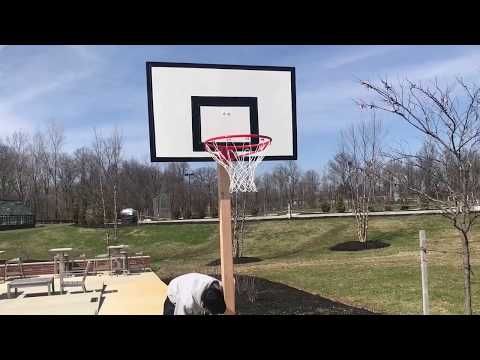 Therefore, if necessary, we can supply everything you need to the object at a wholesale price. We install all this equipment, advise in which cases which is better, etc. We can supply many things both in a finished version and make them ourselves on the spot.
Therefore, if necessary, we can supply everything you need to the object at a wholesale price. We install all this equipment, advise in which cases which is better, etc. We can supply many things both in a finished version and make them ourselves on the spot.
Installation of additional equipment (treadmills, jumping pits, safety fences, grandstands)
You can also be sure that we will carry out all the necessary arrangements for their improvement on the site and the adjacent territory.
Landscaping
The thickness of the foundation pit and the amount of materials that are needed for your foundation, we select depending on the size of the field. We select drainage and other systems based on the regional location (how much precipitation is in your region, what kind of drainage is needed). Additionally, we equip drainage wells, or divert them to the drainage system. Field slopes of several different types depending on site operating conditions.
Preparation of excavation, sand bed, drainage system
The quality of a football field is more than half dependent on the quality of the base! Our base is a monolithic solid single layer, which over the years does not form any fractures, the soil does not go anywhere and remains flat throughout the entire period of operation.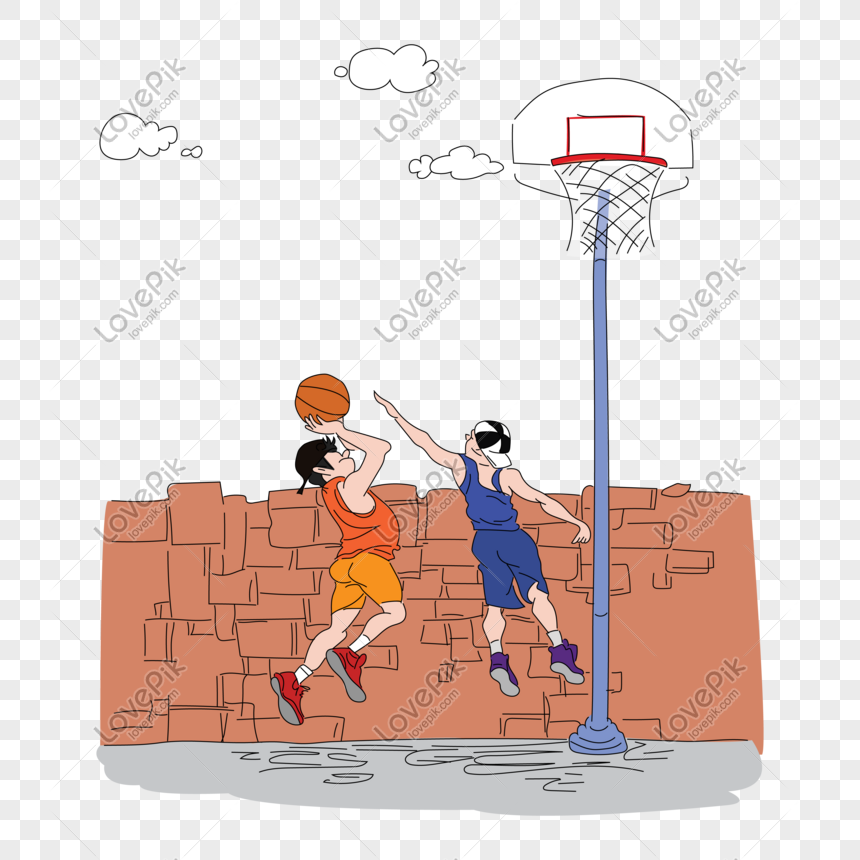 Relatively speaking, even if a tractor passes over the base, there will be no tire marks, because everything is solid and dense!
Relatively speaking, even if a tractor passes over the base, there will be no tire marks, because everything is solid and dense!
Sequential compaction of base layers
We carry out all types of additional improvement works: we can install a fence for you, pave an asphalt path to something, level the territory, paint walls, borders, etc. We will perform all the required related work!
Installation of the curbstone
The laying of the artificial grass itself is as important as the preparation of the base. When laying the field, an important aspect is gluing the rolls and cutting the markings. Gluing must be done securely. The material in the work requires getting used to, because the two-component glue rolls down after a while and they need to work quickly.
Laying the grass on the prepared base, gluing it and cutting the markings
Be sure to remember: the gate is installed with a safety requirement so that it does not turn over. Therefore, this aspect is given special importance.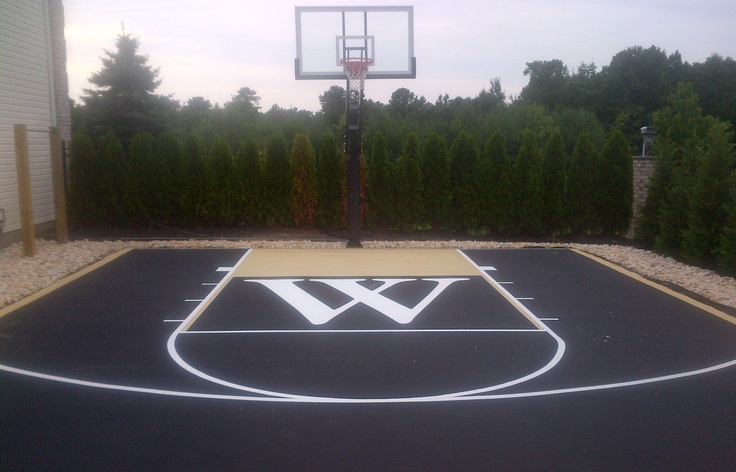 In this regard, the gate is either concreted or attached to an accompanying fence.
In this regard, the gate is either concreted or attached to an accompanying fence.
Installation of the goal
The backfill of a football field determines a large part of the performance of the game. Backfilling is a responsible job, because the presence or absence of drops and bumps, which will eventually be felt during the game, depends on the uniform distribution of sand and crumb rubber on sports grounds. That is, there should be both a flat base and a high-quality pile with an even distribution of backfill under it.
Raising grass, distributing sand and crumb rubber across the field
We cooperate with the largest manufacturers of stands, fences and other sports equipment in the Russian Federation. Therefore, if necessary, we can supply everything you need to the object at a wholesale price. We install all this equipment, advise in which cases which is better, etc. We can supply many things both in a finished version and make them ourselves on the spot.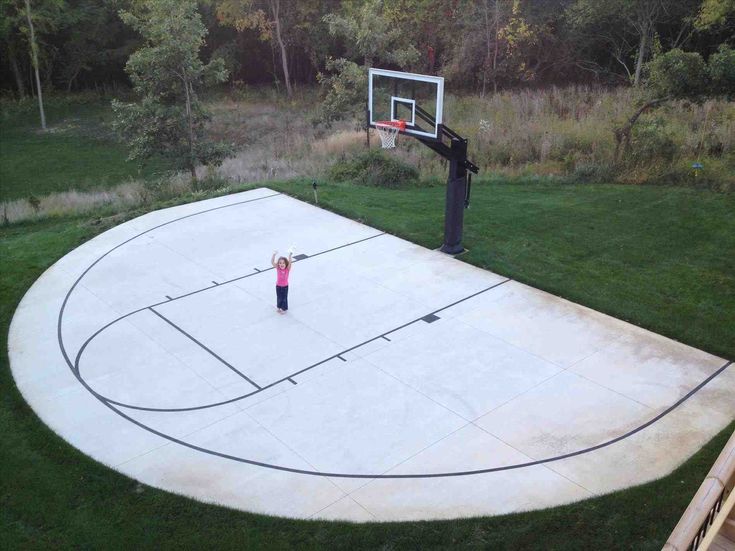
Installation of additional equipment (treadmills, jumping pits, safety fences, grandstands)
You can also be sure that we will carry out all the necessary arrangements for their improvement on the site and the adjacent territory.
Landscaping
Options
How do we work?0003
We carry out construction and installation works
We hand over the finished object and provide a guarantee
Private
I am a private client
We work in all regions of the Russian Federation
We cooperate with contractors who are ready to travel to any city in Russia. We take measurements, bring materials or buy them in your city, install coatings and equipment.
We offer standard solutions
We are engaged in the construction of both standard and unique projects.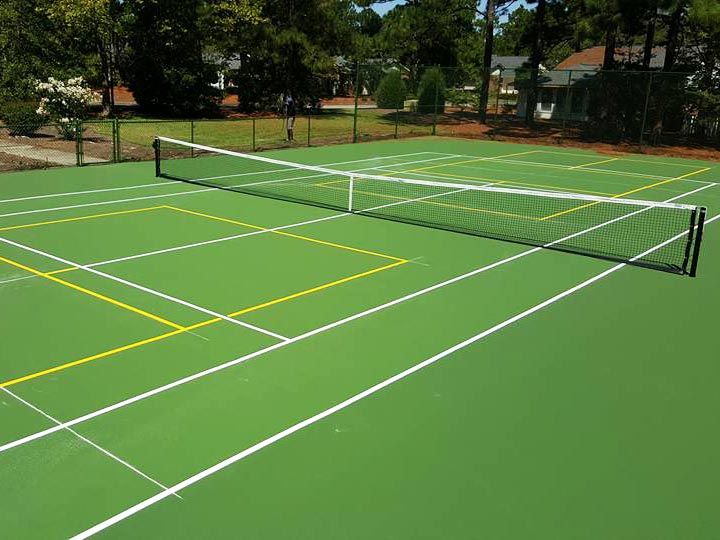 We work individually with each client: we take into account your wishes, fit into the budget and comply with the agreed deadlines.
We work individually with each client: we take into account your wishes, fit into the budget and comply with the agreed deadlines.
We take care of your budget
We help clients in the selection of materials, places for construction, provide detailed advice and suggest how to get a fully functional sports facility at a lower cost.
We create 3D visualization
We offer the development of a 3D model that will convey a complete vision of the concept of the future object. Also, this service will help both us and the client to eliminate the possibility of error at the design stage.
We make reconstruction and repair
We carry out all types of reconstruction works: we repair the foundation, lay the foundation, replace the coatings, install fences, roof structures, make glazing and ennoble the areas.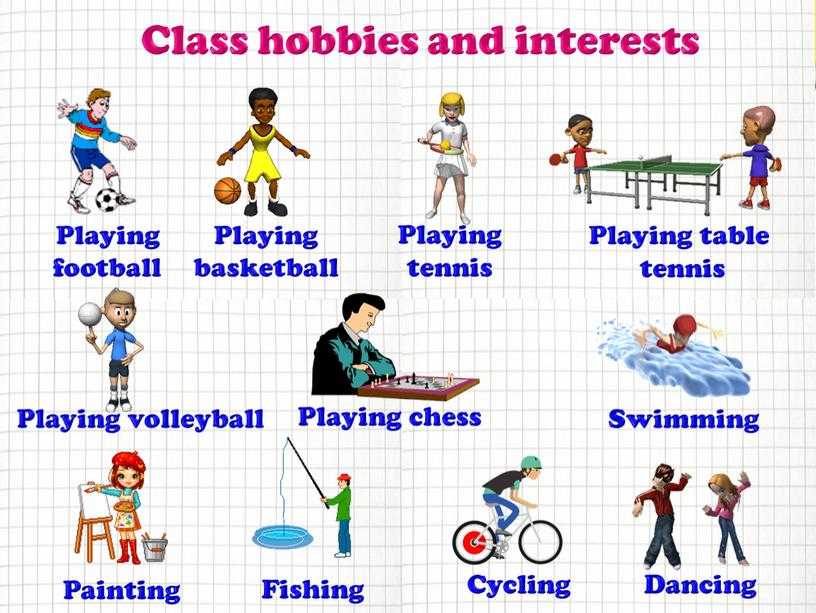
I am a frequent customer
Corporate
I am a corporate client
We offer additional services
We are engaged in maintenance of the facility after commissioning: we take care of the condition of sports surfaces, ennoble areas, do glazing and other general construction work.
We take on complex projects
We have enough experience and capabilities to solve the most non-standard and complex tasks. Many of our specialists took part in the preparation of sports grounds for the Olympic Games in Athens and the 2018 World Cup.
We cooperate with global companies
We maintain strong partnerships with well-known manufacturers from Europe and Asia. At the request of the customer, we supply the goods you like from abroad in the shortest possible time.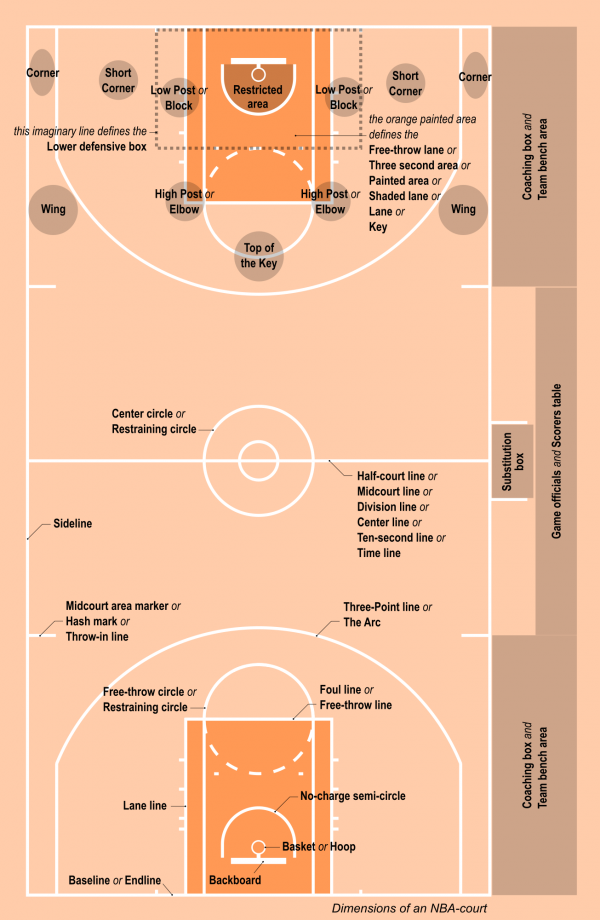
We provide detailed advice
We answer in detail all the client's questions about the project and our services. Also, we are ready to provide professional legal advice on construction issues.
We build turnkey facilities
We provide a whole range of services: designing an object, drawing up design estimates, building a foundation and base, selecting and laying coatings, erecting roofed structures, installing appropriate equipment and necessary communications.
Our clients
I am a corporate client
Acknowledgments and certificates of conformity
Company "SportObject" offers its services in the field of sports construction. We are engaged in the construction of turnkey basketball courts: we design, draw up design estimates, coordinate the construction, mount the foundation and roof structures, lay bases and coverings, perform finishing work, provide communications and deliver sports equipment.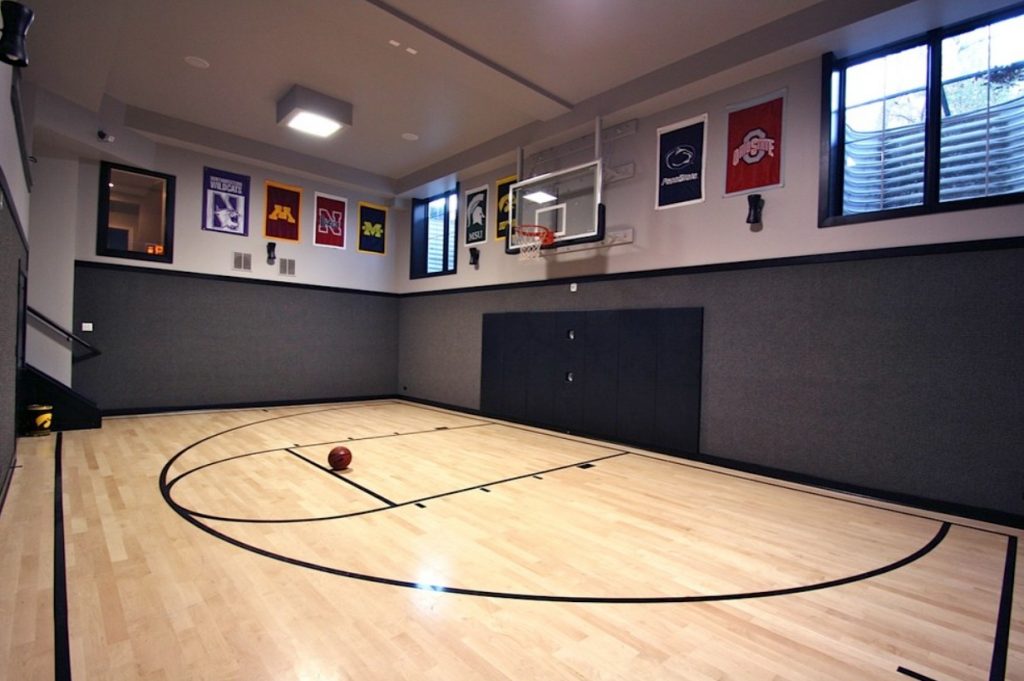 Each of the stages of work is implemented strictly according to the schedule agreed with the client, which allows us to deliver a fully finished project on time.
Each of the stages of work is implemented strictly according to the schedule agreed with the client, which allows us to deliver a fully finished project on time.
We value the trust of each customer and guarantee comfortable cooperation
- We travel to any place in Russia;
- We provide detailed advice on construction issues;
- We select high-quality solutions for the client's budget;
- We help with the choice of an advantageous place for construction;
- We work with complex and non-standard ideas;
- We offer creative solutions within a reasonable budget;
- We provide additional facility maintenance in other regions of Russia.
We supply basketball surfaces from world manufacturers
The dynamics of basketball matches means high speed, sudden movements and heavy loads on the joints. It is very important that the flooring of the basketball court is both wear-resistant and injury-proof at the same time.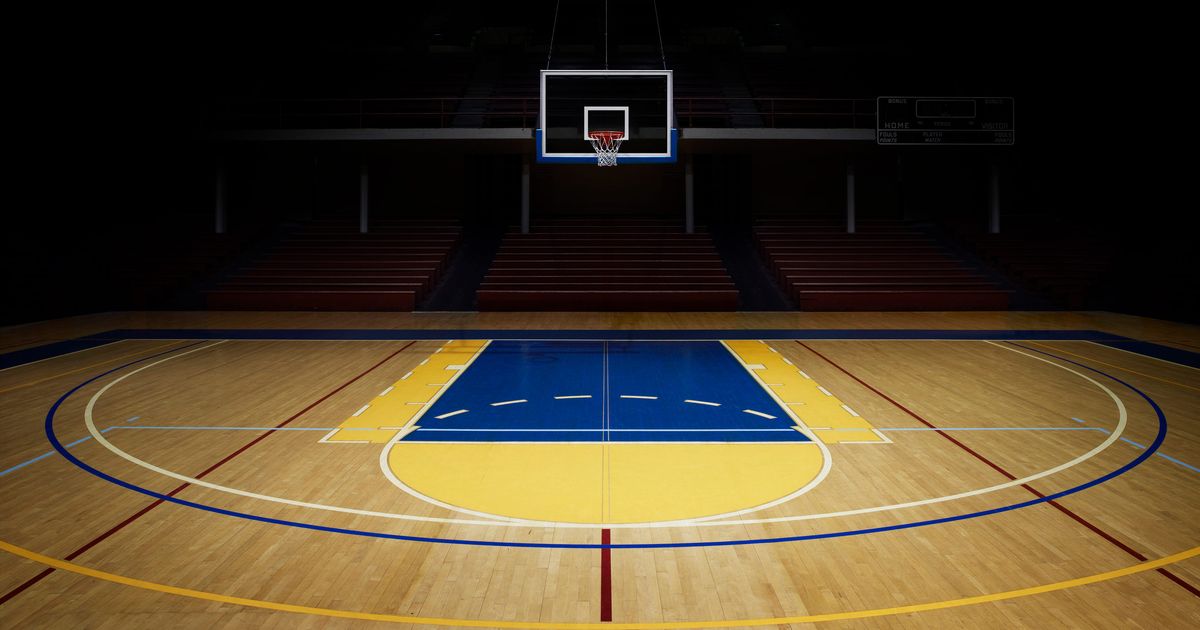 For basketball courts we offer: tennis, hard or soft-hard, modular plastic, polyurethane coating and crumb rubber coating.
For basketball courts we offer: tennis, hard or soft-hard, modular plastic, polyurethane coating and crumb rubber coating.
Our company only works with proven materials that have passed the strictest quality control, so we offer a wide selection of outdoor basketball surfaces from domestic and foreign manufacturers, such as: ERFOLG , BERGO , PLASTFACTO , Conica , Novol , Aropa , CRUMB , GUMBIT 9099 , MASTER FIBER and many more.
In addition to the construction of basketball courts, we take care of the complete set of the object and provide it with all the necessary equipment until it is ready for operation. In accordance with the requirements of the customer, any sports equipment can be installed: backboards, rings, stands of a certain capacity, running tracks, a sector for standing long jumps and, of course, various types of fences.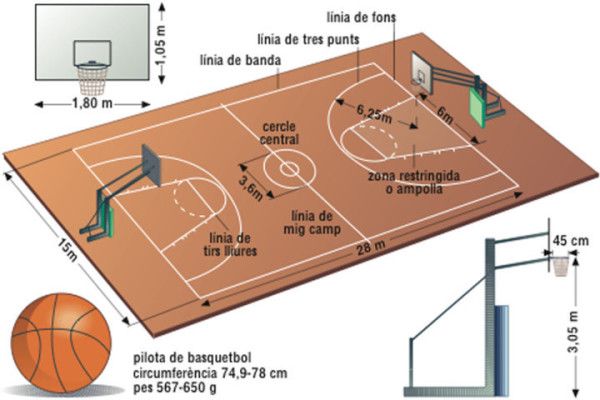
We offer metal railings or safety nets for the customer's choice
- Metal 2D and 3D fences are sectional structures of increased strength with rod diameters from 4 to 6 mm, protected by a polymer and zinc coating. Unlike other fences, mesh panel fencing is maintenance-free - it does not get dusty, does not fade in the sun and does not deform under wind loads, and also does not need periodic painting
- Protective mesh made of kapron or nylon threads can have different mesh sizes: 100x100, 40x40 or 20x20. Such a fence is ideal for zoning the playing space and protecting spectators from sports equipment. The mesh does not need maintenance and is easily restored
As we build new basketball courts, we also work with existing facilities that need a major overhaul or minor restoration. We are happy to undertake the design of a sports facility, without including construction work, and for the implementation of the facility according to an already finished project.